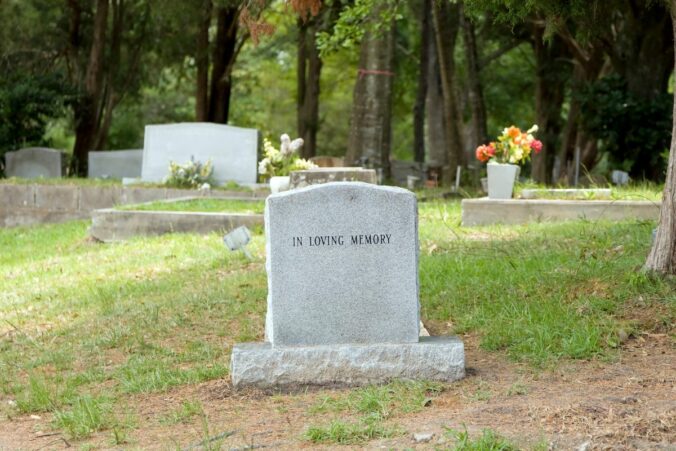Table of Contents
Ah, headstones. Those timeless monuments to the dearly departed. And, just like anything else, they need to be cleaned every once in a while. and just like cleaning a house, car, etc.
You have to actually put in some elbow grease to keep these things looking spick and span.
Now, I know what you’re thinking. Why should I care about a bunch of old stones in a cemetery?” Well, for starters, it’s a sign of respect for the deceased. If you wouldn’t want your house or room to be left a mess, why would you want your loved one’s final resting place to be any different?
Plus, preserving headstones helps to ensure that future generations can still pay their respects and learn about the lives of those who came before us. It’s like leaving a little piece of history behind.
But, before you grab the nearest bottle of bleach and get to work, there’s something you should know. Using harsh chemicals on headstones can actually do more harm than good.
They can damage the surface of the stone and cause discoloration. That’s why it’s important to use natural cleaning methods. Not only are they gentler on the headstones, but they’re also better for the environment.
So, grab a cup of coffee, sit back, and get ready to learn everything you need to know about cleaning a gravestone the natural way.
Understanding the Material of the Headstone
So, you’ve decided to take on the task of cleaning a headstone. Good for you! But, before you start scrubbing away, there’s one important thing you need to know: not all headstones are created equal.
That’s right, folks. Some are made of granite, some of marble, and others of sandstone. And, each type of stone requires a different cleaning approach. So, let’s dive into the world of headstone materials and learn how to identify what we’re working with when cleaning stones.
Let’s start with the basics. There are three main types of headstones: granite, marble, and sandstone.
Granite is the most durable and resistant to weathering, while a marble surface is a bit more delicate and prone to scratches. Sandstone is somewhere in between and can be quite porous, which means its surface is more susceptible to staining.
Now, you might be thinking, “So what? I’ll just use the same cleaning method for every stone.” Well, I hate to be the bearer of bad news, but that’s not how it works.
The type of stone will impact what cleaning products and methods you can use on the surface as well as each step you should take when you clean each type. For example, using vinegar on a marble headstone can actually cause etching, which will leave permanent damage.
How to identify the type of headstone:
So, how do you know what type of stone surface you’re dealing with? There are a few ways to find out. One is to look at the color and texture of the surface itself.
Granite is typically grey and has a grainy appearance, while marble is often white or light in color and has a smooth surface. Sandstone is typically a warm brown color and has a rough, porous surface.
Another way to determine the type of stone surface is to check for a manufacturer’s label or to consult with a professional.
In conclusion, understanding the material of the headstone is key to cleaning the surface effectively and safely. So, before you start scrubbing away, take the time to figure out what you’re working with.
And, as always, if in doubt, consult a professional. They’re the experts, after all.
Preparing for Cleaning The Gravestone
Alright, you’ve identified the type of stone you’re dealing with and you’re ready to get to work. But, before you start, there are a few things you need to do to prepare.
Trust me, taking these steps will make the cleaning process a lot smoother and less frustrating. So, let’s get started.
Gather the necessary materials to clean the headstones
First things first, you need to gather your supplies. You’ll need a soft-bristled brush, a bucket, a mild soap, and a source of water. You might also want to bring along a towel or cloth to dry the gravestone after you clean it.
And, if you’re going to clean a larger stone, you might want to consider bringing a ladder. Safety first, folks.
Safety precautions when cleaning gravestones
Now, before you start to clean, there are a few safety precautions you need to take. First, make sure the gravestone is stable. You don’t want it toppling over while you’re scrubbing away.
Second, be careful when using a ladder. Make sure it’s on level ground and that someone is holding it steady.
And, finally, be mindful of your surroundings. If you’re going to clean a marker in a cemetery, watch out for other visitors and make sure you’re not blocking any paths.
Protect the surrounding area:
It’s also important to protect the surrounding area before you start to clean. Place a tarp or plastic sheet under the marker to catch any drips or runoff. This will help to prevent damage to the grass or plants in the area.
And, if you’re going to clean a headstone in a cemetery, it’s also a good idea to place a tarp around the base of the stone to protect any flowers or decorations that might be there.
In conclusion, preparing to clean is just as important as the cleaning itself. Taking the time to gather your supplies, take safety precautions, and protect the surrounding area will make the cleaning process a lot smoother and less frustrating.
So, take a deep breath and get ready to tackle that stone.
Removing Loose Debris From the Stone
Alright, you’ve prepared to clean and you’re ready to get started. The first step to clean a marker is to remove any loose debris that might be on the surface. This will make the cleaning process a lot easier and more effective.
So, let’s dive into the world of debris removal.
The best tool for removing debris from the stone is a soft-bristled brush. You don’t want to use a brush with stiff bristles as that could damage the surface of the stone.
A soft brush will be gentle enough to remove debris without causing scratches.
Another option for removing debris is to use a vacuum or a broom. This is especially useful if there are large amounts of leaves or other debris on the stone.
Just make sure you’re using a soft-bristled broom to avoid causing scratches.
If there is moss or lichen growing on the stone, it’s important to remove it carefully. These plants can damage the surface of the stone over time and can also harbor moisture, which can cause damage.
To remove moss or lichen, you can use a soft brush or a mixture of water and vinegar.
In conclusion, removing loose debris from a marker is an important first step in the cleaning process. By using a soft brush, a vacuum or broom, or a mixture of water and vinegar, you can effectively remove debris and prepare the stone for cleaning.
So, grab your brush and get ready to tackle that debris.
How To Clean Headstones with Soap and Water
Now that you’ve removed any loose debris, it’s time to cover how to clean the stone. The simplest and most straightforward method that you can use to clean it is to just use soap and water.
It’s a gentle and effective way to get a headstone cleaned, and, best of all, it’s something you probably already have in your home. So, let’s get to it how to clean it with these simple ingredients.
Use of a mild soap:
The first step to clean with soap and water is to choose the right soap. You don’t want to use just any old soap. No, no, no. You want to use a mild soap, like dish soap or laundry detergent.
Harsh soaps can damage the surface of the stone surface and cause discoloration.
Preparation of the solution:
Once you’ve selected your soap, it’s time to prepare the cleaning solution. Fill a bucket with warm water and add a few drops of soap. Stir the solution until the soap is dissolved.
Application of the solution:
Now, it’s time to start cleaning. Dip your soft-bristled brush into the solution and start scrubbing the stone.
Pay extra attention to any areas that are particularly dirty or stained. Once you’ve scrubbed the entire marker, rinse it thoroughly with clean water.
In conclusion, the process to clean headstones with soap and water is a simple and effective. By using mild soap, water, and a soft-bristled brush, you can have effective stone cleaning and won’t have to worry about damaging the surface of the stone either.
So, grab your soap and water and get ready to tackle that stone surface.
Using Baking Soda
Baking soda, the magic ingredient that can do just about anything. Cleaning your kitchen, neutralizing odors, and now, cleaning gravestones.
That’s right, folks. Baking soda is a great alternative to traditional cleaning products and it’s gentler on the stone and the environment. So, let’s get baking.
Baking soda is a mild abrasive that can effectively remove dirt, grime, and stains from a headstone without damaging the surface. It’s also a natural deodorizer, so it can help to neutralize any unpleasant odors that might be lingering around the cemetery.
Preparation of a baking soda solution:
To prepare a baking soda solution, simply mix equal parts baking soda and water. Stir the mixture until the baking soda is dissolved.
Now, it’s time to start cleaning. Dip your soft-bristled brush into the solution and start scrubbing the stone. Pay extra attention to any areas that are particularly dirty or stained.
Once you’ve scrubbed the entire stone, rinse it thoroughly with clean water.
In conclusion, using baking soda is a great alternative to traditional cleaning products. Its mild abrasive properties make it effective in removing dirt, grime, and stains from a headstone, and its natural deodorizing properties make it a great choice for cleaning gravestones in a cemetery.
So, grab your baking soda and get ready to tackle that stone.
Using Vinegar
Vinegar, the versatile liquid that’s been cleaning everything from windows to floors for centuries. And now, it’s time for it to tackle gravestones. That’s right, folks.
Vinegar is a great natural cleaning product that’s gentle on gravestones and the environment. So, let’s pour some vinegar and get to work.
Vinegar is an acidic substance that can effectively remove dirt, grime, and stains from gravestones. It’s also a natural deodorizer, so it can help to neutralize any unpleasant odors that might be lingering around the cemetery.
Preparation of a vinegar solution:
To prepare a vinegar solution, simply mix equal parts water and vinegar. You can use white vinegar or apple cider vinegar, depending on your preference.
Now, it’s time to start cleaning. Dip your soft-bristled brush into the solution and start scrubbing the gravestones. Pay extra attention to any areas that are particularly dirty or stained.
Once you’ve scrubbed the entire headstone, rinse it thoroughly with clean water.
In conclusion, using vinegar is a great alternative to traditional cleaning products. Its acidic properties make it effective in removing dirt, grime, and stains from gravestones, and its natural deodorizing properties make it a great choice for cleaning headstones in a cemetery.
So, grab your vinegar and get ready to tackle those gravestones.
Using Lemon Juice
Lemon juice, the tangy liquid that’s been used for everything from cooking to cleaning. And now, it’s time for it to tackle headstones.
That’s right, folks. Lemon juice is a great natural cleaning product that’s gentle on gravestones and the environment. So, let’s squeeze some lemons and get to work.
Lemon juice is an acidic substance that can effectively remove dirt, grime, and stains from gravestones. It’s also a natural deodorizer, so it can help to neutralize any unpleasant odors that might be lingering around the cemetery.
Preparation of a lemon juice solution:
To prepare a lemon juice solution, simply squeeze the juice from a few lemons into a bowl. You can also use bottled lemon juice if you prefer.
Now, it’s time to start cleaning. Dip your soft-bristled brush into the solution and start scrubbing the gravestones. Pay extra attention to any areas that are particularly dirty or stained.
Once you’ve scrubbed the entire headstone, rinse it thoroughly with clean water.
In conclusion, using lemon juice is a great alternative to traditional cleaning products. Its acidic properties make it effective in removing dirt, grime, and stains from a headstone, and its natural deodorizing properties make it a great choice for cleaning headstones in a cemetery.
So, grab your lemons and get ready to tackle that headstone.
Alternative Cleaning Methods
So, you’ve tried soap and water, baking soda, vinegar, and lemon juice and you’re still not satisfied with the results. Don’t worry, folks. There are still a few alternative cleaning methods you can try.
Just remember, before trying any new method, it’s important to test it in a small, inconspicuous area first to make sure it won’t damage the headstone.
Using commercial cleaners:
If you’re not satisfied with natural cleaning methods, you can try using a commercial headstone cleaner specifically designed for headstones. These cleaners are available at most hardware or home improvement stores and can be effective in removing dirt, grime, and stains.
Just make sure to follow the manufacturer’s instructions carefully.
Consulting with a professional:
If you’re still not happy with the results, you can always consult with a professional. They’ll be able to assess the headstone and recommend the best cleaning method for your specific situation.
Just be prepared to spend a bit more money, but the peace of mind might be worth it.
In conclusion, if natural cleaning methods aren’t getting the job done, there are still a few alternative methods you can try. From using commercial cleaners to consulting with a professional, there are plenty of options available.
So, don’t give up, folks. Keep trying until you get the results you want.
Pros of using natural methods when cleaning a headstone:
| Method | Pros |
|---|---|
| Soap and water | Gentle, safe for the environment, readily available, and effective at removing dirt, grime, and stains. |
| Baking soda | Mild abrasive, natural deodorizer, safe for the environment, and effective at removing dirt, grime, and stains. |
| Vinegar | Acidic, natural deodorizer, safe for the environment, and effective at removing dirt, grime, and stains. |
| Lemon juice | Acidic, natural deodorizer, safe for the environment, and effective at removing dirt, grime, and stains. |
Cons of using natural methods when cleaning a headstone:
| Method | Cons |
|---|---|
| Soap and water | May not be effective at removing deep-seated dirt and stains. |
| Baking soda | May not be effective at removing deep-seated dirt and stains. |
| Vinegar | Can etch the surface of the headstone if left on for too long. |
| Lemon juice | Can etch the surface of the headstone if left on for too long. |
Conclusion
Well, folks, that’s it. You’ve made it to the end of this exciting journey. You’ve learned how to clean a headstone naturally and you’re now an expert in the field of headstone cleaning. Congratulations!
Cleaning a headstone can seem like a daunting task, but with the right tools and a little bit of know-how, it’s actually quite simple. From soap and water to baking soda and vinegar, there are plenty of natural cleaning methods that are gentle on the headstone and the environment.
And, if all else fails, you can always consult with a professional.
But, beyond the cleaning itself, it’s important to remember the significance of headstones. They’re more than just markers in a cemetery. They’re a part of our history and they deserve to be preserved.
By taking the time to clean a headstone, you’re not only honoring the memory of the person it represents, but you’re also preserving a piece of history for future generations.
In conclusion, cleaning a headstone is a simple and rewarding task. Whether you choose to use soap and water, baking soda, vinegar, or lemon juice, you’ll be able to effectively clean the headstone and preserve a piece of history.
So, grab your cleaning supplies and get to work!
- Difference Between a Monument and a Memorial: More Than Just Stone-Cold Facts! - November 16, 2025
- Difference Between a Headstone and a Gravestone: The Ultimate Rock Rivalry - November 16, 2025
- Different Headstone Shapes: A Grave Decision Guide to Monument Styles - November 16, 2025



Leave a Reply